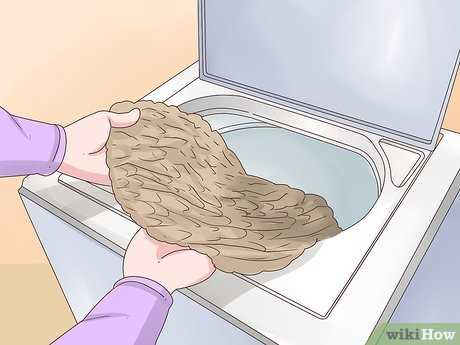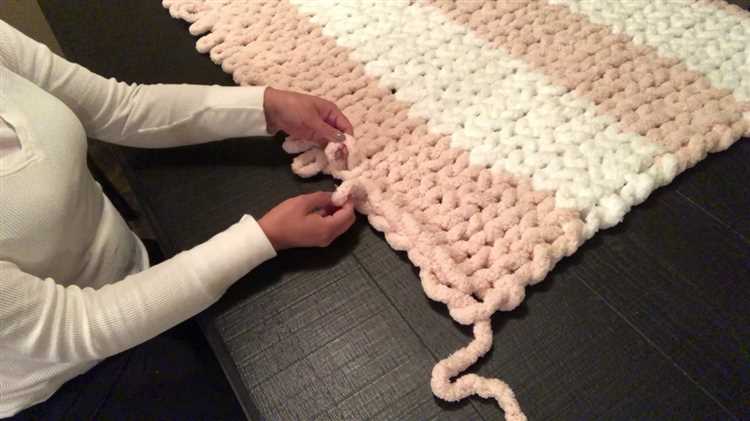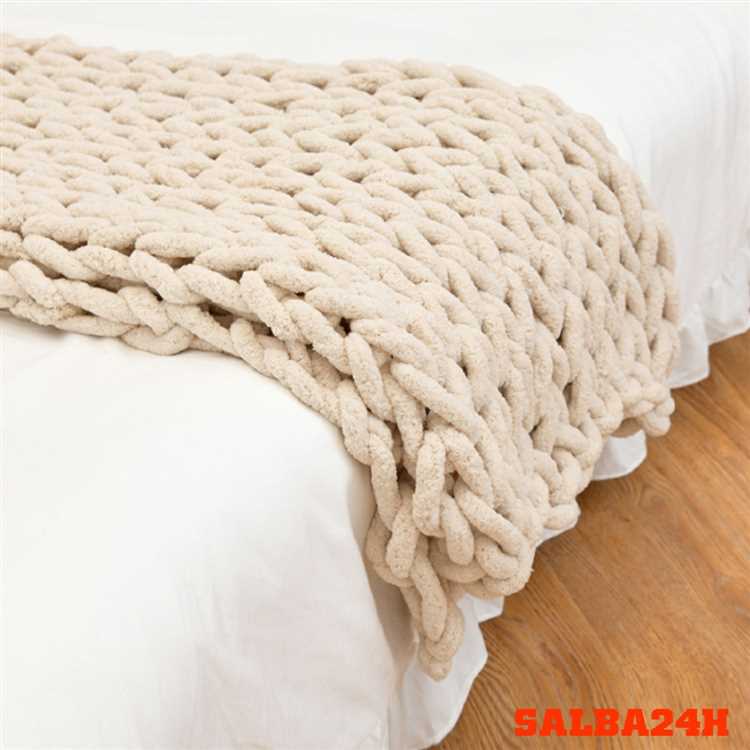Knitted blankets are not only cozy and warm, but they also add a touch of style and texture to any home decor. However, washing a knitted blanket can be a daunting task, as the delicate fibers can easily be damaged if not handled properly. In this article, we will provide you with some useful tips and techniques on how to wash your knitted blanket to keep it clean and in pristine condition.
1. Check the Care Instructions
Before proceeding with washing your knitted blanket, it is important to check the care instructions provided by the manufacturer. Some knitted blankets may require specific cleaning methods or be dry clean only. It is crucial to follow these instructions to avoid any potential damage to the blanket.
If the care instructions are not available or you’ve misplaced them, you can always opt for hand washing to ensure gentle cleaning.
2. Prepare the Washing Solution
When washing a knitted blanket, it is essential to use a mild detergent specifically designed for delicate fabrics. Avoid using harsh detergents or bleach, as they can weaken the fibers and cause discoloration. Fill a sink or basin with lukewarm water and add a small amount of the detergent. Swirl the water with your hand to create a gentle, sudsy solution.
3. Wash the Blanket
Place the knitted blanket in the prepared washing solution and gently agitate it with your hands. If there are any stubborn stains, you can lightly rub them with your fingers or a soft brush. Avoid twisting or wringing the blanket, as this can stretch or distort the shape. After thoroughly washing the blanket, drain the soapy water and refill the sink or basin with clean water. Rinse the blanket by swishing it gently in the clean water until all the detergent is removed.
4. Dry the Blanket
When it comes to drying a knitted blanket, it is crucial to handle it with care to avoid stretching or misshaping the fibers. Gently squeeze out excess water from the blanket without wringing or twisting it. Lay the blanket flat on a clean, dry towel and roll it up to remove any remaining moisture. Unroll the towel and transfer the blanket to a flat surface, such as a drying rack or clean towel. Shape the blanket back to its original dimensions and allow it to air dry. Avoid exposing the knitted blanket to direct sunlight or heat sources, as this can cause fading or shrinking.
Remember, knitted blankets require extra care and attention when it comes to washing. By following these simple tips and techniques, you can ensure that your knitted blanket stays clean, soft, and cozy for years to come.
Preparing the Blanket
Before washing your knitted blanket, it’s important to take a few preparatory steps to ensure a successful cleaning process:
- Check the Care Instructions: Look for any specific washing instructions provided by the manufacturer. Some knitted blankets may require specific cleaning methods or temperature settings.
- Inspect for Damage: Take a close look at your knitted blanket to identify any loose threads, holes, or other signs of damage. Repair any damages before washing to prevent further unraveling.
- Remove Stains: If there are any visible stains on your knitted blanket, it’s best to pretreat them before washing. Follow the stain removal instructions for the specific type of stain, as different methods may be required.
- Secure Buttons or Zippers: If your knitted blanket has any buttons or zippers, make sure they are securely fastened. This will prevent them from snagging and damaging the fabric during the washing process.
- Close Velcro Fastenings: If your knitted blanket has any Velcro fastenings, ensure they are closed. This will prevent the Velcro from grabbing onto other fabric in the washing machine.
- Turn Inside Out: To protect the outer surface of your knitted blanket and minimize pilling, turn it inside out before placing it in the washing machine.
- Sort by Color and Material: Separate your knitted blankets into different loads based on color and material. Washing dark and light colors separately can help prevent color bleeding and fading. Similarly, washing different materials separately can protect delicate fabrics.
- Remove Excess Debris: Shake or brush off any loose dirt, pet hair, or other debris from your knitted blanket before washing. This will prevent these particles from clogging the washing machine or clinging to the fabric.
- Choose a Gentle Detergent: Select a mild, gentle detergent that is suitable for delicate fabrics. Avoid using strong detergents and bleach, as they can damage the fibers of your knitted blanket.
By following these preparatory steps, you can ensure that your knitted blanket is ready for a thorough and safe washing process.
Choosing the Right Washing Method
When it comes to washing a knitted blanket, it is important to choose the right washing method to ensure that the blanket stays in good condition. Here are some considerations to keep in mind:
- Check the care instructions: Before washing the knitted blanket, always check the care instructions provided by the manufacturer. They will indicate the recommended washing method for that particular blanket.
- Hand wash for delicate blankets: If the care instructions recommend hand washing, it is best to follow them. Fill a basin or sink with lukewarm water and a gentle detergent. Gently agitate the blanket in the water, being careful not to stretch or wring it. Rinse the blanket thoroughly and squeeze out excess water without twisting.
- Machine wash for sturdier blankets: Some knitted blankets may be suitable for machine washing. Place the blanket in a mesh laundry bag to protect it from snagging. Use a gentle cycle and cold water, along with a mild detergent specifically formulated for delicate fabrics. Avoid using bleach or fabric softener.
- Dry flat: Whether you choose to hand wash or machine wash the knitted blanket, always dry it flat to avoid stretching. Lay it on a clean, dry towel and gently roll it up to remove excess water. Then, reshape the blanket and lay it flat on a clean, dry surface to air dry.
- Avoid hanging or wringing: Hanging a wet knitted blanket or wringing it out can stretch the fibers and cause it to lose its shape. It is best to follow the instructions for drying flat to maintain the blanket’s original size and texture.
By choosing the right washing method and taking proper care of your knitted blanket, you can ensure that it stays soft, cozy, and in good condition for years to come.
Hand Washing vs. Machine Washing
When it comes to washing a knitted blanket, you have the option of either hand washing or machine washing. Each method has its pros and cons, so it’s important to consider what is best for your blanket.
| Hand Washing | Machine Washing | |
|---|---|---|
| Pros |
|
|
| Cons |
|
|
Ultimately, the decision between hand washing and machine washing will depend on the condition of your knitted blanket, the time and effort you’re willing to invest, and your personal preference. If your blanket is delicate or has intricate details, hand washing may be the safer option. On the other hand, machine washing can be a convenient choice if your blanket is more durable and you have a busy schedule.
Regardless of the method you choose, always follow the care instructions provided by the manufacturer or any specific recommendations for your particular blanket. This will help ensure that your knitted blanket stays clean, soft, and beautiful for years to come.
Selecting the Right Detergent
When it comes to washing a knitted blanket, it’s important to use the right detergent. The detergent you choose can have a significant impact on the results of your wash. Here are some tips for selecting the right detergent:
- Mild and Gentle: Opt for a detergent that is mild and gentle. Harsh detergents can damage the delicate fibers of the knitted blanket.
- Wool-Safe: Look for a detergent that is specifically labeled as safe for wool or delicate fabrics. These detergents are formulated to protect the fibers and maintain the softness of the blanket.
- Free from Bleach and Enzymes: Avoid detergents that contain bleach or enzymes, as these can cause discoloration and break down the fibers of the blanket.
- Neutral pH: Consider using a detergent with a neutral pH. This helps to prevent any potential damage to the fibers and keeps the colors of the blanket vibrant.
Before using a new detergent on your knitted blanket, it’s a good idea to test it on a small, inconspicuous area of the blanket to ensure that it doesn’t cause any adverse effects. Additionally, always follow the manufacturer’s instructions on the detergent packaging for the best results.
Washing the Blanket
Properly washing your knitted blanket is important to maintain its quality and extend its lifespan. Follow these steps to ensure a successful washing process:
- Read the Care Instructions: Before washing your knitted blanket, refer to the care instructions provided by the manufacturer. It will give you specific guidance on how to wash the blanket.
- Pre-Treat Stains: If your blanket has any stains, it is advisable to pre-treat them before washing. Gently blot the stains with a mild detergent or stain remover to loosen the dirt.
- Choose the Right Water Temperature: Generally, it is recommended to wash knitted blankets in lukewarm water to prevent shrinking or damaging the fibers. Avoid using hot water as it can cause the fibers to lose their shape and elasticity.
- Select a Gentle Detergent: Use a mild detergent specifically designed for delicate fibers. Avoid using harsh detergents or bleach, as they can weaken the fibers of your blanket.
- Hand-Wash or Machine-Wash: Depending on the care instructions, you can choose to either hand-wash or machine-wash your knitted blanket. However, it is generally safer to hand-wash delicate knits to prevent any damage. If using a washing machine, set it to a gentle cycle with a slow spin speed.
- Handle with Care: When washing your knitted blanket, avoid agitating or wringing it too harshly, as this can lead to stretching or distortion of the fibers. Instead, gently swirl or squeeze the blanket to remove excess water.
- Reshape and Dry Flat: After washing, carefully reshape your knitted blanket to its original size and dimensions. Lay it flat on a clean towel or drying rack to air dry. Avoid hanging the blanket to dry, as it can cause it to stretch.
- Store Clean and Dry: Once the blanket is completely dry, fold it neatly and store it in a clean and dry place to prevent any moisture or mildew buildup.
Following these steps will help ensure that your knitted blanket remains soft, cozy, and in excellent condition for years to come.
Drying the Blanket
After washing your knitted blanket, it is important to dry it properly to maintain its shape and prevent any damage. Here are a few tips for drying your knitted blanket:
- Squeeze out excess water: Before drying, gently squeeze out the excess water from the blanket. Avoid wringing or twisting the fabric as it can stretch or damage the fibers.
- Roll in a towel: Lay the blanket flat on a clean towel and roll it up to absorb more moisture. Press down gently on the rolled towel to remove as much water as possible.
- Reshape the blanket: After removing excess moisture, carefully reshape the blanket to its original size and shape. Smooth out any wrinkles or bumps and make sure the corners are in place.
- Drying flat: Lay the blanket flat on a clean, dry surface, preferably on a clean towel or drying rack. Avoid hanging the blanket as it can cause the weight of the wet fabric to stretch and distort the shape.
- Flip and rotate: Flip and rotate the blanket occasionally during the drying process to ensure even drying. This will also help maintain the shape and prevent any warping.
- Patience: Drying a knitted blanket may take some time, especially if it is thick or made of wool. Be patient and allow the blanket to air dry completely before using or storing.
Remember to always follow the care instructions provided by the manufacturer or consult a professional cleaner if you are unsure about the specific drying instructions for your knitted blanket. Proper drying ensures that your knitted blanket stays soft, cozy, and in good condition for a long time.
Preventing Shrinkage and Stretching
When washing a knitted blanket, it is important to take precautions to prevent shrinkage and stretching. Here are some tips and techniques to help you maintain the size and shape of your knitted blanket:
- Use cold water: Washing your knitted blanket in cold water helps minimize the risk of shrinkage. Hot water can cause the fibers to contract and shrink.
- Gently agitate: Avoid vigorously agitating or wringing the knitted blanket, as this can stretch the fabric. Instead, gently swirl or squeeze the blanket to remove excess water.
- Use a gentle detergent: Choose a mild and gentle detergent specifically designed for delicate fabrics. Avoid using harsh chemicals or bleach, as they can damage the fibers of the knitted blanket.
- Avoid excessive soaking: Minimize the time your knitted blanket spends in water to prevent stretching. Soak it for only a few minutes, and then proceed to the rinsing step.
- Support the weight: When lifting or carrying a wet knitted blanket, support its weight evenly to prevent stretching. Avoid hanging it up to dry, as the weight of the water can cause the fabric to stretch.
- Allow flat drying: Lay your knitted blanket flat on a clean, dry surface to dry. Avoid using a clothesline or hanger, as this can cause the blanket to stretch and lose its shape.
- Gently reshape if needed: If your knitted blanket has stretched slightly during washing, gently reshape it while it is still damp. Use your hands to smooth out any wrinkles and restore the original shape.
By following these tips and techniques, you can help prevent shrinkage and stretching when washing your knitted blanket, ensuring that it stays in great condition for years to come.
Tips for Maintaining the Blanket’s Shape
When washing a knitted blanket, it’s important to take certain steps to maintain its shape. Follow these tips to ensure that your blanket stays in good condition:
- Gently squeeze out excess water: After washing, avoid wringing or twisting the blanket as it can stretch and distort its shape. Instead, gently squeeze out the excess water using your hands or by pressing it between two towels.
- Reshape while damp: While the blanket is still damp, carefully reshape it to its original dimensions. Smooth out any wrinkles or folds and straighten the edges to maintain a uniform shape.
- Use blocking methods: If your blanket still loses its shape after washing, consider using blocking methods. This involves pinning the blanket to a foam mat or blocking board and using rust-proof T-pins to hold it in place while it dries.
- Avoid hanging: Avoid hanging a wet or damp knitted blanket to dry, as it can stretch and cause the blanket to lose its shape. Instead, lay it flat on a clean towel or blocking mat to air dry.
- Store properly: When not in use, store your knitted blanket flat or rolled up to prevent it from stretching or becoming misshapen. Avoid folding it in half repeatedly, as this can weaken the fibers and lead to permanent creases.
By following these tips, you can help maintain the shape of your knitted blanket and ensure its longevity.
FAQ:
Can I put a knitted blanket in the washing machine?
Yes, you can put a knitted blanket in the washing machine, but you should use a delicate or hand wash cycle to prevent damage.
What is the best way to hand wash a knitted blanket?
The best way to hand wash a knitted blanket is to fill a basin or sink with lukewarm water and gentle detergent. Soak the blanket for about 15 minutes, then agitate it gently to remove dirt. Rinse the blanket with clean water, press out excess water, and lay it flat to dry.
How often should I wash a knitted blanket?
It depends on how often the blanket is used and how dirty it gets. In general, washing the knitted blanket once every few months or when it appears dirty is sufficient.
Can I use bleach to clean a knitted blanket?
No, it is not recommended to use bleach on a knitted blanket as it can damage the fibers and cause them to weaken or break. Instead, opt for gentle detergents that are safe for delicate fabrics.
What should I do if my knitted blanket shrinks after washing?
If your knitted blanket shrinks after washing, you can try to gently stretch it back to its original size while it is still damp. Lay the blanket flat and pull gently in all directions until it returns to its desired dimensions. Be careful not to pull too hard, as this can damage the fibers.


